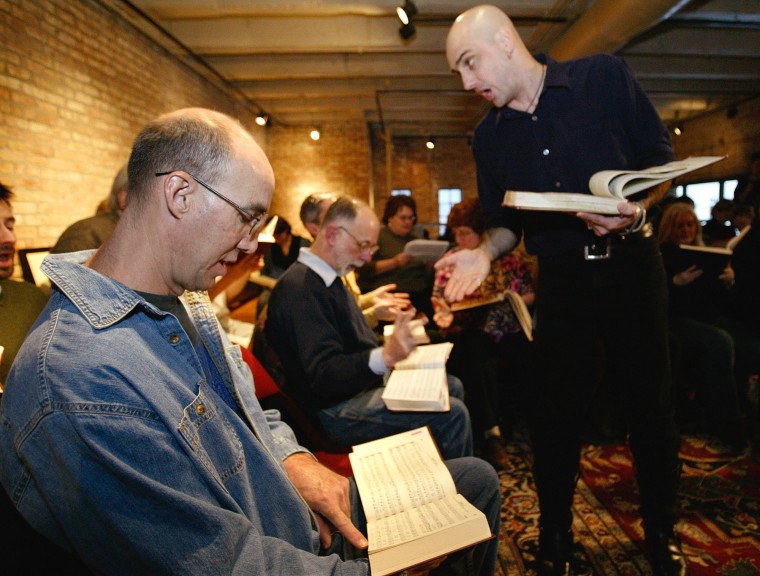Surrounded by other singers arranged in a square, Judy Hauff rocks her feet heel to toe, rhythmically slashes the air with her arm and sings “Fa la sol la sol.”
This is “shape note” music, an a cappella, traditional form of folk hymn singing that dates to Colonial times. Also known as Sacred Harp music, it’s enjoying a revival after being featured in the film “Cold Mountain” and on its soundtrack.
“It’s America’s best kept musical secret,” said Hauff at a recent workshop at the Old Town School of Folk Music.
In the Civil War-era movie, which is nominated for seven Academy Awards, the shape note song “Idumea” is played over a battle scene. Another scene, in a church, features the characters singing “I’m Going Home” from their Sacred Harp hymnals when they are interrupted with news that the war has begun.
Sacred Harp uses printed shapes to help untrained singers read the music. A triangle represents fa, a circle for sol, a square for la and a diamond for mi. There is no musical accompaniment — “harp” refers to the most-used tune book, “The Sacred Harp,” first published in 1844.
Also unique is the way singers are organized — in an open square, with tenors, bass, alto and treble voices each taking a side. Singers take turns leading the group and beat their hands to keep time.
The result is a loud, clear, almost astringent sound that some describe as ancient, others like a human bagpipe or organ. Singers usually perform a song using its notes before singing the lyrics. And everyone is expected to participate — there is no division between a choir and audience.
“It’s not for listening,” said Tim Eriksen, who sings and appears in “Cold Mountain” and who led the workshop in which Hauff participated. “You can listen to it ... But the beauty of this really comes in the singing.”
Some Sacred Harp enthusiasts hope “Cold Mountain” will do for shape note singing what the “O Brother, Where Art Thou?” soundtrack did for bluegrass. Both soundtracks were produced by T Bone Burnett.
Eriksen’s workshop was so popular that organizers rearranged the room and expanded the class size from 35 to 80. In other cities, long-established Sacred Harp groups are attracting new people. And while only two Sacred Harp songs appear on the “Cold Mountain” soundtrack, there is talk of releasing an entire CD filled with shape note music from the “Cold Mountain” sessions.
The “Cold Mountain” shape note music for the soundtrack and movie was recorded at Liberty Baptist Church on Alabama’s Sand Mountain, although bits of the stars’ singing voices were later blended in.
Eriksen was hired to teach the actors how to sing shape note music so that they would look realistic on film. His singing voice was also dubbed in for that of a singing fiddler, and he appears on the soundtrack and in the church scene leading the song.
A world music expert and former punk rocker from Massachusetts who discovered shape note singing in his teens, Eriksen, 37, symbolizes the variety of people the music attracts. And while the hymns are Christian in nature, the performances are not outwardly religious.
Music resurfacing
Sacred Harp music was replaced in many parts of the country in the second half of the 19th century by religious hymns. But it found a permanent home in rural areas of the South, where “singing conventions” cropped up and people would travel for miles to sing for hours, or days, at a time.

About 20 years ago, Sacred Harp attracted new enthusiasts, many of them curious participants on college campuses and in churches in New England and the Midwest.
In Chicago, Hauff, 60, and Ted Johnson, 75, were part of a group of about a dozen folk-music fans who discovered Sacred Harp music in the early 1980s. Intrigued, they traveled to the South to learn from people who had grown up singing the music.
“It just blew us away,” Johnson remembered.
Now there are Sacred Harp groups across the nation and many enthusiasts fly cross-country on weekends to join other groups. Richard DeLong, who performed in the Liberty Baptist Church recordings, hopes the new exposure will help keep Sacred Harp music alive.
“We’re delighted to welcome new people all the time,” said DeLong, who was taken to his first shape note singing as a baby by his grandmother in rural Georgia. “It won’t take them very long — if they keep coming, they’ll get hooked, just like the rest of us, and be part of the extended musical family.”